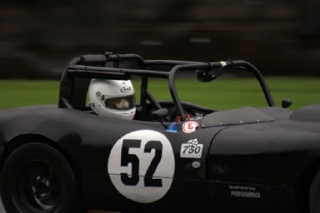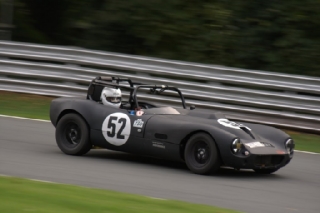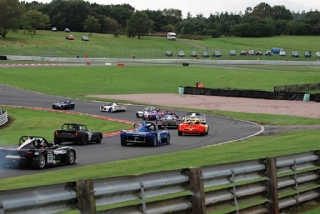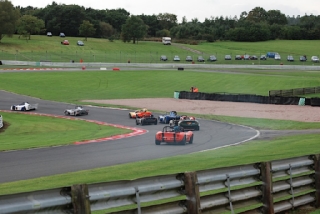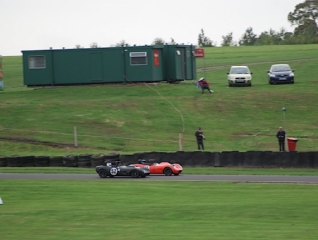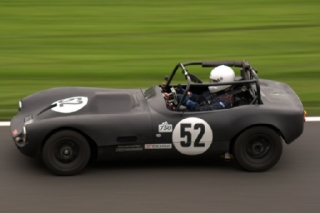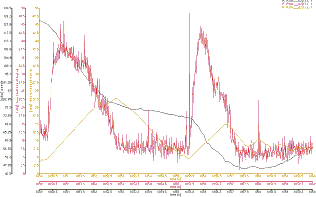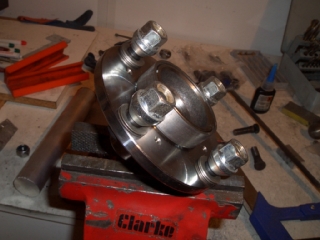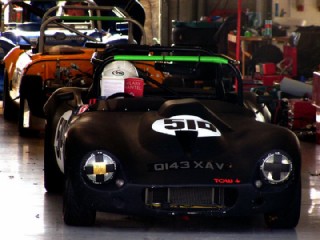And so for the traditional 750MC season closer. The Birkett, for those
as don't know, as a rather unusual race. It's contested by teams of between 4 and 6 drivers, who can either drive
different cars (which is normally the case) or who can share cars (which does also happen). It's a relay race,
so when one car comes into the pits, the next car can leave the pits once the incoming car has passed the pit garage.
There's a wide range of different cars taking part, although, I have to say, not as wide a range as there used
to be - the Frazer Nash chain-driven cars are missing these days but definitely not forgotten. I still remember
watching the Chain Gang's drivers look over their shoulders towards the outside of the track to make sure they had enough space for the back end of the car
to swing round into - since they have no diff, every corner has to be taken in a glorious opposite lock slide.
However, even with their absence, there's still everything from modern wings'n'slicks racers to classic saloons
out on track - and a rather lovely little blue Turner Mk3, which was beautifully turned out. And there was rather
a lot of cars as well - there were 60 teams taking part this year, so there was anything up to 60 cars on track
at any one time.
This number of cars could be accommodated because we were, for the first time, using the Grand Prix circuit at
Silverstone. The Historic GP circuit in this case, not the new 'Arena' circuit which was used for this year's F1
race. I understand that it's likely that the Birkett will be the last time the Historic GP circuit is ever used,
as it seems that the continued construction work to the circuit will mean that it won't be possible to use it in
the future. A pity, as it's a great track.
However, it's a track I'd never driven on before. I've driven the Silverstone National circuit, but that only shares
two corners, Luffield and Copse, with the GP circuit - if you ignore Woodcote as a corner, and in the dry it's
not really a corner at all, although that all changes when the track's damp. Given that I'd never driven the circuit
before, some testing seemed like a good idea, so as well as doing my usual rFactor track-familiarisation I booked
a day's testing on the Friday before the race. Unfortunately, it then turned out that I'd got two seminars to give
that day, so I couldn't make it. Indeed, I wouldn't be able to get home before 8pm on Friday night, at which point
getting the car from the Shed and troggling over to Silverstone seemed a bit futile. So instead, I stayed at home
on Friday night, and set the alarm for 4 a.m. By 4.25 a.m. I was on the road, by 5 a.m. I had the trailer trundling
along behind the car, and at 6.35 a.m. I arrived at Silverstone, still well before dawn. Car off the trailer, round
to the pits, sign on at race control, off to scrutineering (no problems there) and back to the pit garage for 7.25
a.m., all done and dusted. Given that my qualifying session was due to start until 9.30 a.m., that left me 2 hours
to wonder why the hell I'd got up so early.
My qualifiying session was at 9.30 a.m. because I was car 'D' in our team, RGB East, number 51. The other members
in the team were fellow cam7ers Tim and Adrian, fully-fledged race god Derek Jones, Class A man-to-beat Paul Rogers and
David Wale in his BDN S2. Now the only way I was going to be as fast as Derek was to hire Robert Kubica as a chauffeur.
Tim's not that much slower than Derek these days and can match him on a good day, while Paul's long list of outright
victories this year puts him consistently at the pointy end of the field. David is also usually towards the front
of the grid, and I thought it unlikely I'd be able to match his pace. However, I wasn't *that* much slower than
Adrian round Oulton Park, and was hoping to put in lap-times similar to his. Provided it was dry...
During the week before the race, I'd been nervously keeping an eye on the BBC weather forecast for Northampton.
During the early part of the week the BBC were confidently predicting heavy rain all day on race-day. This was
not a prospect I relished, as I don't like racing in the wet, quite apart from anything else due to the fact that
I'm no bloody good at it. However, by Thursday the Beeb had decided that it was going to be glorious sunshine all
day on Saturday, and this was still their prediction on Friday. In the end, neither of the forecasts was even vaguely
correct, which just goes to show that all that money they spend on creating weather models would be much spent
on a pair of dice and a look-up table - 'a 3 and a 5 - heavy showers in the west, sunny intervals in the east'.
I suspect a pair of dice would be more reliable than the systems they've got at the moment anyway.
To be fair, when I arrived at the circuit it was indeed dry with a clear sky. However, it had evidently rained
overnight and the ground was still fairly damp. And it was still damp when it came to qualifying. I spent the out
lap and the next three laps making sure the circuit went where rFactor thought it did. By and large it did, although
because we were using the Historic GP circuit (rather than the not-quite-Historic circuit they'd run in testing
the day before) we were using the cut-through at the entry to Club, which turned the entry from a sharp 90 left
followed by a sharp 90 degree right into a pair of roughly 45 degree corners. Much faster than the version of the
circuit I'd be using on rFactor, and one I never felt I got right during the whole weekend. Although by the time
it got to my qualifying slot the sun was definitely out and shining brightly, it was still pretty cold, and the
track didn't seem to be drying out much if at all. It was certainly still pretty greasy out there during qualifying.
Once I'd bagged the three laps I needed to qualify, I started pushing a bit harder, seeing where the grip was and
seeing where it was possible to carry speed through the corners. I think my best time during the quali session
was a 2:38 - far from blistering, but apparently a respectable time when compared to the other RGB racers present. |
|
